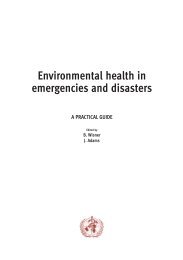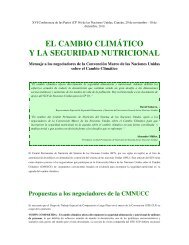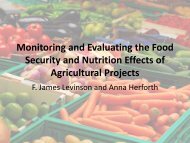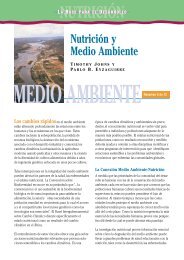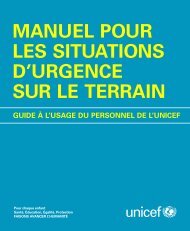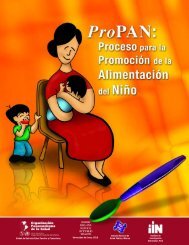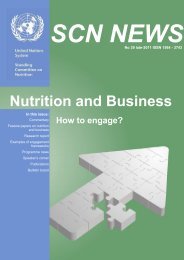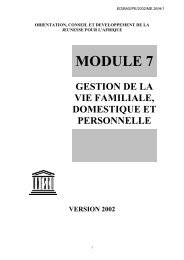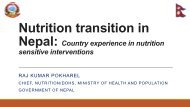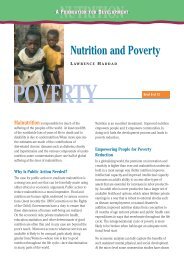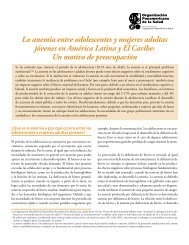SCN News No 36 - UNSCN
SCN News No 36 - UNSCN
SCN News No 36 - UNSCN
Create successful ePaper yourself
Turn your PDF publications into a flip-book with our unique Google optimized e-Paper software.
www.unsystem.org/scn PUBLICATIONS 79<br />
Water and the Rural Poor: Interventions for<br />
improving livelihoods in Sub-Saharan Africa<br />
FAO (online)<br />
The document looks at the water resources<br />
that are available in sub-<br />
Saharan Africa and at their potential role<br />
in improving agriculture and the livelihoods<br />
of the rural poor. The report argues<br />
that improvements in agriculture<br />
are one of the options to reduce poverty,<br />
and that interventions should be adapted<br />
to local conditions and populations, as<br />
there is no one-fits-all solution. To this effect for instance, the report<br />
distinguishes 13 types of livelihood zones across sub-<br />
Saharan Africa. This comprehensive report is articulated around 3<br />
broad themes: Water, agriculture and rural livelihoods; Mapping<br />
poverty, water and agriculture in sub-Saharan Africa; Interventions<br />
in water to improve livelihoods in rural areas. www.fao.org<br />
Protein-Energy Malnutrition<br />
JC Waterlow FRS with contributions from A Ashworth, AM<br />
Tomkins and SM Grantham McGregor<br />
Reprint with added new material 2007<br />
Hailed on first publication in 1992 as ‘a state-of-the-art publication<br />
on nutrition and PEM for the 90s’ Protein-energy Malnutrition<br />
is a critical, authoritative review of the subject for doctors and<br />
health workers. The reprinted version now presented here is<br />
supplemented by 22 pages of updated new material. The detailed<br />
discussion of treatment, aimed specifically at paediatricians<br />
and health workers, is supported by an analysis of the nature<br />
of severe and fatal cases. An account of how the existence<br />
of malnutrition is characterized in the community by impaired<br />
growth, frequent infections and retardation of mental development<br />
leads to an analysis of the still controversial question of<br />
strategy and methods for prevention. Thus the potential readership<br />
is widened to include public health officials, aid agencies<br />
and medical advisers.<br />
Available from Smith-Gordon priced at £35.<br />
For students and health professionals in the field who work in countries<br />
experiencing PEM the book is available at lower cost of £10.<br />
Contact cvenditti@smith-gordon-publishing.com<br />
See also www.talcuk.org/books/protein-energy-malnutrition.htm<br />
Toolkit for Addressing Nutrition in Emergency Situations<br />
IASC Global Nutrition Cluster<br />
(online)<br />
The Nutrition Cluster Toolkit is intended<br />
as an easy-to-use field guide<br />
that outlines the key basic interventions<br />
for nutritional support to individuals and<br />
groups during an emergency situation.<br />
It provides the what, why, when,<br />
and how for different nutrition interventions,<br />
including basic monitoring benchmarks and expected standards.<br />
The Toolkit offers guidance and support for nutritionists<br />
and humanitarian workers to ensure that basic guidelines are<br />
followed and the basic nutritional needs of populations in emergencies<br />
are met. It is not intended to be an exhaustive resource<br />
for each intervention presented, but rather an overview for interventions<br />
to be considered with references and links to more detailed<br />
technical guidance for each issue.<br />
http://ocha.unog.ch/humanitarianreform<br />
See also detailed description p.64<br />
Impact of Climate Change and Bioenergy on Nutrition<br />
Cohen MJ, Tirado C, Aberman NL,<br />
Thompson B - IFPRI/FAO<br />
(online)<br />
This paper, prepared for the High<br />
Level Conference on World Food Security:<br />
The Challenge of Climate<br />
Change and Bioenergy (Rome, 3-5<br />
June 2008), explores the implications<br />
of climate change and rising bioenergy<br />
demand for nutrition. It examines<br />
the direct nutrition effects of rising<br />
bioenergy demand, as well as its contribution to rising food<br />
prices. The paper begins by describing the current state of<br />
global food insecurity and malnutrition and the causes, consequences<br />
and costs of food insecurity and malnutrition. A number<br />
of factors besides climate change, bioenergy and rising prices<br />
that can contribute to malnutrition in the future are also discussed.<br />
Finally, a chapter on policy implications provides several<br />
options for improving food security and nutrition, as well as for<br />
addressing the links between climate change and bioenergy<br />
demand and nutrition. www.ifpri.org www.fao.org<br />
Climate Change: implication for Food Safety<br />
FAO (online)<br />
The paper aims to identify potential<br />
impacts of anticipated changes in climate<br />
on food safety and their control at<br />
all stages of the food chain. The purpose<br />
is to raise awareness of the issue<br />
and to facilitate international cooperation<br />
in better understanding the changing<br />
food safety situation and in developing<br />
and implementing strategies to<br />
address them. www.fao.org<br />
Feeding the world:<br />
Sustainable Management of<br />
Natural Resources<br />
FAO (online)<br />
www.fao.org<br />
1. Dairy Development for the Resource Poor: A Comparison<br />
of Dairy Policies and Development in South<br />
Asia and East Africa<br />
2. Dairy Development for the Resource Poor: Kenya and<br />
Ethiopia Dairy Development Case Studies.<br />
3. Dairy Development for the Resource Poor: Pakistan<br />
and India Dairy Development Case Studies.<br />
Staal SJ, Pratt AN, Jabbar M<br />
(online 1, 2 and 3)<br />
This study examines dairy development in two key dairy producing<br />
regions in the developing world: East Africa and South Asia.<br />
The aim of the study is to analyse the trends in dairy development<br />
in these two regions and identify their key determinants, to assess<br />
the impact of policy interventions on those trends and to identify<br />
impacts of dairy development, particularly on the poor. The study<br />
is reported in three parts.<br />
www.fao.org<br />
back to contents <strong>SCN</strong> NEWS # <strong>36</strong>




